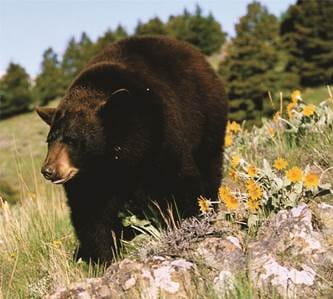Released on May 4, 2017
Every spring is the same: black bears and other predators, especially young ones, frequently move around to establish new territory and look for food. This is normal behaviour for wildlife, but it can cause challenges for humans.
Residents are reminded to take the necessary safety precautions when outdoors, enjoying Saskatchewan’s natural areas, our parks or campgrounds. In some cases, urban areas have been built along natural wildlife corridors such as rivers, forests and valleys.
Wildlife travelling these corridors can sometimes come into conflict with people and property in those areas. If you encounter a bear, cougar or some other predator, keep your distance and do not try to scare the animal away or handle the situation yourself.
Remember, don’t leave garbage and pet food out. This may attract bears and other predators. Additional information about predator safety is available online at www.saskatchewan.ca/residents/environment-public-health-and-safety/wildlife-issues/protect-yourself-and-your-property.
Anyone who finds themselves in a potentially dangerous situation with a bear or other predator should contact their local conservation officer or call the 24-hour Turn In Poachers line at-1-800-667-7561 or from your cell at #5555.
Bear Safety Tips
Most bears are cautious around humans. They rarely charge or chase a human.
If you encounter a bear:
- Stay calm – don’t run!
- Make a wide detour, calmly back away, speak in low tones, and don’t look directly at the bear.
- Never feed or approach a bear or cubs.
- Move toward a tree or rock.
- As a last resort, drop articles to distract the bear.
- In most cases, black bears will threaten but not attack.
- If attacked – defend yourself – DO NOT PLAY DEAD.
While hiking or walking, keep your pet on a leash. An unleashed dog may aggravate a bear. You should never feed or approach a bear. Generally, bears are attracted by food and if they cannot find food they will often leave the area.
Bears that have been fed lose their natural fear for humans. When bears start to associate food with humans, they may damage property and become dangerous.
Cougar Safety Tips
Cougar/human conflicts are rare. Cougars are generally shy and wary of humans and typically avoid human activity and populations.
If you do encounter a cougar:
- Stay calm – don’t run!
- Make sure the cougar knows you are not potential prey – stand up, make yourself appear as large as possible, shout loudly and throw something to distract the animal.
- Back away to a safe distance while maintaining eye contact with the cougar.
- If a cougar does make contact, fight back. Use any weapon that you can and don’t give up.
- Never play dead with a cougar.
- After the cougar has left, keep watching for it until you reach a place of safety.
In Saskatchewan, cougars are a natural part of the landscape, especially in the Cypress Hills region and along the entire length of the forest fringe from Meadow Lake to Hudson Bay. These animals are a sign of healthy ecosystems and sightings often go unreported. Although chances of seeing a cougar are slim, residents need to be aware of their existence in the area and practice caution and safety when outdoors.
-30-
For more information, contact:
Jamie Gibson
Environment
Regina
Phone: 306-798-3900
Email: jamie.gibson@gov.sk.ca

